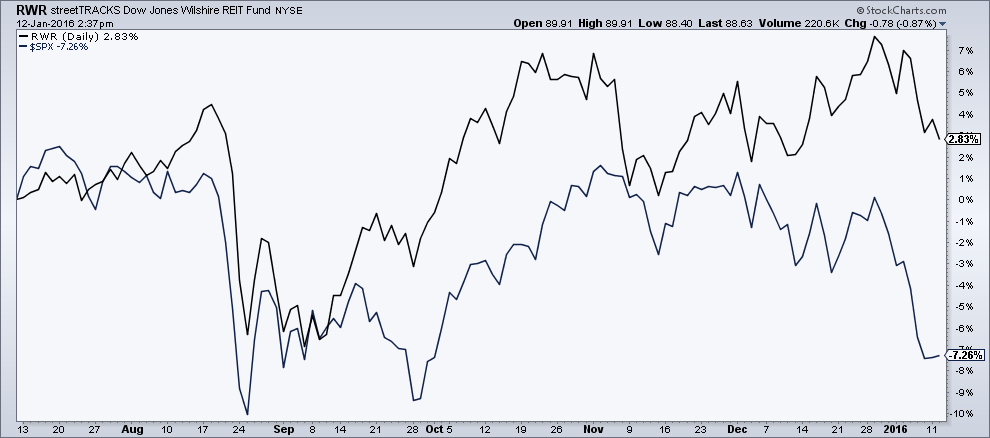At the request of so many investment advisors, my friends at Riskalyze share the big trends in the assets going into and coming out of advisor portfolios every week. The underlying data is aggregated from hundreds of thousands of client accounts across the $120 billion and counting that advisors manage on the Riskalyze platform*. I hope we can uncover interesting trends for you each week…
January 3rd – January 9th
-
Real Estate (RWR)
-
Dow Jones 30 (DIA)
-
Short term Corporate Bonds (VCSH)
Losers (advisor flows FROM these investments increased substantially):
-
Large Cap US Equities (SPY, QQQ, IVW)
-
Small Cap US Equities (IWM)
-
Short Duration US Gov Bonds (IEF)
Josh here – it’s tough to be able to say whether or not last week’s bout of stock selling on the part of advisors was tactical because of the global crash or psychological because of client fear or seasonal and having more to do with previously scheduled rebalancing. At my shop, we don’t do the typical July-and-January rebalance because we think we’ve found a more opportune way to do it, but many advisors are on that semi-annual schedule.
Regardless of why, advisors were actually net sellers of equity funds during the first week of January. According to Mike McDaniel, CIO of Riskalyze, there was a “7% decrease in advisor use of US Equities (SPY, IWM, QQQ, IVW) in the first week of the year.”
Interestingly, advisors didn’t let the volatility of stocks keep them away from REITs, one of the few asset class darlings of this young year. One of the ETF sites I read mentioned that creations in REIT ETFs were at the top of the Billboard charts last week. Riskalyze data confirms this: Says Mike, “use of RWR week over week increased by over 20%.”
Why REITs? Why now?
My thesis is that, given the trainwreck in China and the resulting tumult everywhere else, plus the commodity crash’s acceleration and the weakening of US manufacturing data, it’s becoming increasingly clear that rates aren’t going up in the first half of 2016. Less competition from rising treasury yields and low risk of an uptick in mortgage costs is a benefit for the REIT space, pretty much across the board.
But because hiring, employment and corporate profits remain steady, demand for office RE should remain just fine, even if the economy continues to flatline. Hence, the REITs with quality properties, clean balance sheets and high nominal payouts remain attractive and are being bought up.
It doesn’t hurt that The Street has been raising their estimates for REITs – something they’re not doing for any other category I can think of. Merrill Lynch thinks REIT sector earnings growth is 5% in 2016, but Credit Suisse says it will be more like 8%. Both firms estimate that REIT dividend yields will climb by 10%. Put S&P 500-matching earnings growth together with higher dividend growth and the possibility of multiple expansion (thanks to a frozen Fed) and you’ve got a really bullish story to tell, in a relative desert for positivity.
It also doesn’t hurt that RWR, for example, yields 50% more than the S&P 500 (3% vs 2%) but exhibits less volatility in the current environment. Here’s RWR’s 6 month performance (basically flat) versus the SPX:

So that’s what’s going on. See you next week.
UPDATE: It’s been pointed out to me that because the index companies are beginning to break REITs out of the Financial sector of the S&P, MSCI indices, that creations could be higher than normal as advisors seek to move their portfolios in-line with the benchmarks. My guess is that it’s too early to be seeing that shift among a majority of investors. I could be wrong, interested in any feedback.





RT @ReformedBroker: WHY ADVISORS ARE FLOCKING TO REITS
https://t.co/wDJXL4BMA4
On this week’s @Riskalyze Report https://t.co/QbinTqOloM
RT @ReformedBroker: WHY ADVISORS ARE FLOCKING TO REITS
https://t.co/wDJXL4BMA4
On this week’s @Riskalyze Report https://t.co/QbinTqOloM
RT @ReformedBroker: The Riskalyze Report: Why advisors are flocking to REITs this year https://t.co/hL5mboNYYf
RT @ReformedBroker: WHY ADVISORS ARE FLOCKING TO REITS
https://t.co/wDJXL4BMA4
On this week’s @Riskalyze Report https://t.co/QbinTqOloM
RT @ReformedBroker: WHY ADVISORS ARE FLOCKING TO REITS
https://t.co/wDJXL4BMA4
On this week’s @Riskalyze Report https://t.co/QbinTqOloM
RT @ReformedBroker: WHY ADVISORS ARE FLOCKING TO REITS
https://t.co/wDJXL4BMA4
On this week’s @Riskalyze Report https://t.co/QbinTqOloM
RT @ReformedBroker: WHY ADVISORS ARE FLOCKING TO REITS
https://t.co/wDJXL4BMA4
On this week’s @Riskalyze Report https://t.co/QbinTqOloM
RT @ReformedBroker: WHY ADVISORS ARE FLOCKING TO REITS
https://t.co/wDJXL4BMA4
On this week’s @Riskalyze Report https://t.co/QbinTqOloM
[…] Other pluses: Wall Street has been raising estimates on REITs, rising Treasury yields make them look even more attractive, and demand for office should be just fine as hiring and employment rise. A “really bullish story to tell, in a relative desert for positivity,” says Brown. Read his entire blog here. […]
[…] Other pluses: Wall Street has been raising estimates on REITs, rising Treasury yields make them look even more attractive, and demand for office should be just fine as hiring and employment rise. A “really bullish story to tell, in a relative desert for positivity,” says Brown. Read his entire blog here. […]
[…] Other pluses: Wall Street has been raising estimates on REITs, rising Treasury yields make them look even more attractive, and demand for office should be just fine as hiring and employment rise. A “really bullish story to tell, in a relative desert for positivity,” says Brown. Read his entire blog here. […]
RT @ReformedBroker: WHY ADVISORS ARE FLOCKING TO REITS
https://t.co/wDJXL4BMA4
On this week’s @Riskalyze Report https://t.co/QbinTqOloM
RT @ReformedBroker: The Riskalyze Report: Why advisors are flocking to REITs this year https://t.co/hL5mboNYYf
SEC Settles Charges With Goldman Sachs Over Violated Lending Practices https://t.co/fwZxyaJw97
RT @traderbeam: SEC Settles Charges With Goldman Sachs Over Violated Lending Practices https://t.co/fwZxyaJw97